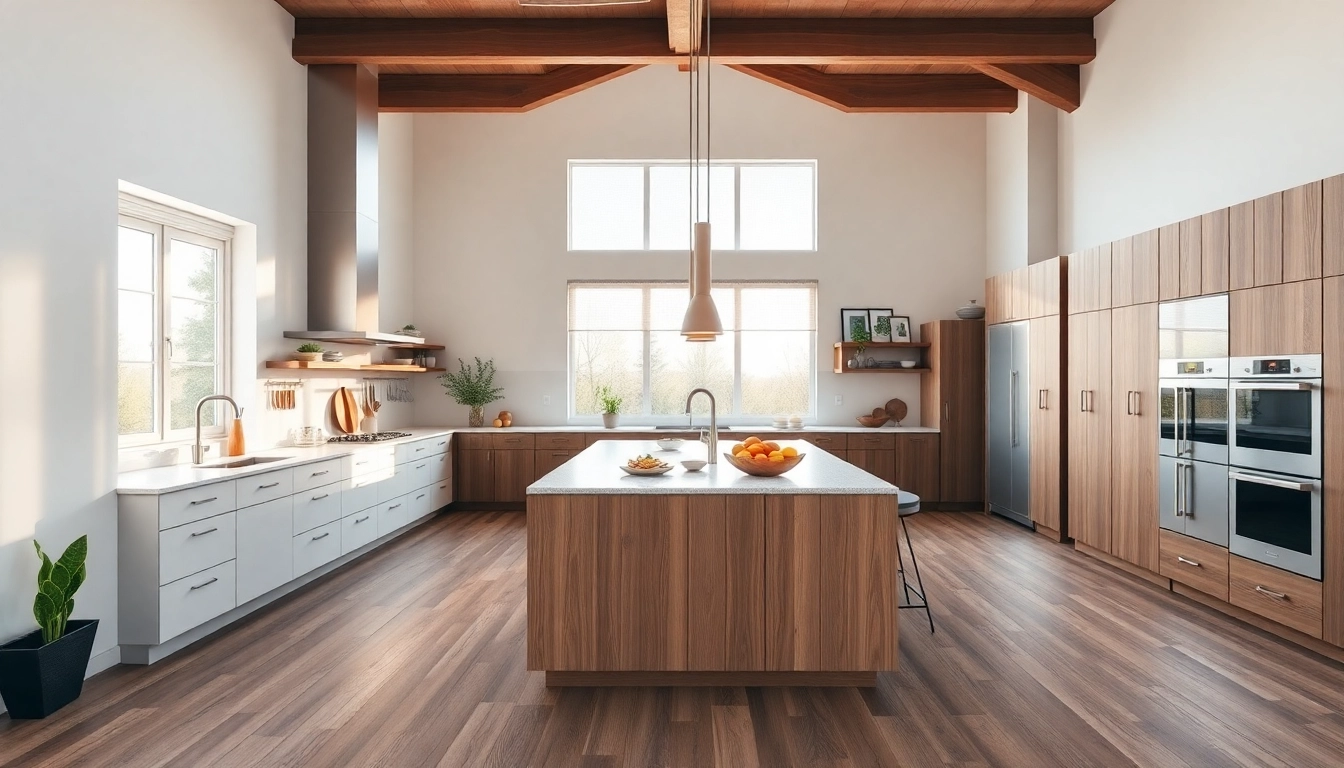Understanding the Basics of Kitchen Remodels
What is a Kitchen Remodel?
A kitchen remodel signifies more than just a simple refresh of your culinary workspace; it embodies a transformative process that can significantly enhance the functionality, aesthetics, and overall value of your home. This process may involve alterations ranging from minor cosmetic upgrades to extensive renovations that reshape the entire layout. Common elements include replacing appliances, cabinets, and countertops, updating fixtures, or even changing the room’s structure with renovations such as removing walls to achieve an open-concept design. Understanding these possibilities is key to appreciating what a kitchen remodel can truly offer.
Key Factors to Consider in Your Kitchen Remodel
Before diving into a remodel project, it’s essential to evaluate a range of factors that will influence the outcome:
- Budget: One of the foremost factors is your available financial resources. Establishing a clear budget will dictate the scope of your remodel, from materials to labor.
- Space: The physical dimensions of your kitchen play a crucial role in determining what changes are feasible. Consider both current and future needs for functionality and flow.
- Style: Your personal style, along with the architectural style of your home, should guide aesthetic choices. Whether you lean toward modern minimalism or rustic charm, consistency in design is vital.
- Needs and Lifestyle: Think about how you and your family use the kitchen. Do you need more storage for gadgets and spices, or is it more important to create a social space?
Setting a Realistic Kitchen Remodel Budget
Establishing your kitchen remodel budget is one of the most critical steps in the planning process. On average, a medium to large kitchen remodel can range from $32,574 to $77,939, depending on various factors like location, materials, and the extent of the remodel. Here are some tips for setting a realistic budget:
- Research Costs: Gather estimates for materials, labor, and any other expenses. Websites and kitchen remodel services often provide tools for estimating costs.
- Include a Contingency: Plan for unexpected expenses by adding a contingency fund of around 10-20% to your overall budget.
- Prioritize Needs: Focus on what is essential versus what would be nice to have. This prioritization will help you allocate resources effectively.
Planning Your Kitchen Remodel
How to Design a Functional Kitchen Layout
Creating a functional layout is crucial for maximizing efficiency in your kitchen. The kitchen work triangle concept—a layout involving the sink, stove, and refrigerator—is a classic way to design efficient kitchens. Here are some layout design strategies:
- Galley Style: Often suitable for smaller spaces, this layout features two parallel walls that house the cooking area and storage.
- U-Shaped Layout: Providing ample workspace, this design utilizes three walls, ideal for larger kitchens or those needing more storage and countertop space.
- Open Concept: Merging the kitchen with adjoining living spaces can create a more community-driven area, ideal for families or entertaining.
- Island Addition: A central island can provide additional counter space, storage, and even seating, making it a versatile feature in modern kitchens.
Sourcing Inspiration for Your Kitchen Remodel
Finding inspiration can be as important as the remodel itself. Utilize various resources to spark your creativity:
- Online Platforms: Websites like Houzz or Pinterest can provide a wealth of ideas from real-life remodels.
- Magazines and Design Books: Home improvement magazines often feature updated kitchen designs with the latest trends.
- Showrooms: Visiting kitchen supply stores or showrooms allows you to see materials and layout options in person.
- Professional Designers: Considering hiring a kitchen designer may offer expertise as well as broader access to current trends and best practices.
Choosing the Right Materials and Finishes
The materials and finishes selected for your kitchen remodel can greatly influence both functionality and aesthetics. Consider these elements:
- Cabinets: Choose between custom, semi-custom, or stock cabinets based on your budget and needs. The material, finish, and hardware can all change the kitchen’s look.
- Countertops: Options include stone, quartz, laminate, and wood, each with its pros and cons regarding durability, maintenance, and cost.
- Flooring: From hardwood to tile to vinyl, choose flooring that offers both style and ease of maintenance.
- Backsplashes: Backsplashes can be a focal point. Choosing colorful tiles or materials can enhance your kitchen’s visual appeal while protecting walls from splashes.
Common Challenges in Kitchen Remodeling
Overcoming Budget Constraints
Budget constraints can be one of the most significant challenges when planning a kitchen remodel. Here are some strategies to make the most of your resources:
- Smart Spending: Focus on high-impact areas where your budget will yield the greatest ROI, such as cabinetry and appliances.
- Consider DIY: Taking on smaller projects yourself (like painting or backsplash installation) can save on labor costs.
- Shop Savvy: Look for sales, shop clearance racks, and consider gently used items for savings without sacrificing quality.
Dealing with Space Limitations
If you’re working with a smaller kitchen, maximizing the available space is crucial. Here are some tactics to consider:
- Vertical Solutions: Utilize wall space for cabinets and shelving to store items without crowding the floors.
- Multi-Purpose Furniture: Options like bar stools that double as storage or foldable tables can save space and add flexibility.
- Open Shelving: This can visually expand the space by allowing the eye to travel upward rather than feeling boxed in.
Navigating Permits and Regulations
Understanding local building codes and regulations is essential to avoid pitfalls during your renovation. Here’s how to navigate these waters:
- Research Local Requirements: Before starting your project, check with your local government to determine what permits are needed for your remodel.
- Consult Professionals: Architects and contractors typically have experience dealing with permits and can help streamline the process.
- Document Everything: Keep thorough records of your plans, permits, and communications, ensuring compliance and providing proof if needed.
Implementing Your Kitchen Remodel
Step-by-Step Guide to Executing a Remodel
The execution of your remodel requires a strategic approach for both efficiency and impact. Follow this step-by-step guide:
- Define Your Scope: Verify what will exactly be included in your remodel, such as new cabinets or layout changes.
- Hire Professionals or DIY: Decide whether you will hire contractors for certain tasks or tackle them yourself based on your skill level.
- Prepare Your Home: Set up a temporary kitchen area and protect unaffected spaces with coverings to minimize disruption and damage.
- Begin Demolition: Remove old materials systematically to ease the installation of new ones.
- Install New Elements: Following the layout plan, install cabinets, countertops, and appliances and finish with flooring and fixtures.
- Final Touches: Add decorative elements like hardware and lighting, ensuring every detail aligns with your vision.
Working with Contractors vs. DIY Remodeling
While DIY projects can be rewarding and cost-effective, they come with their challenges. Evaluating whether to do it yourself or hire professionals can be a deciding factor in your remodel’s success:
- Skills Assessment: Honestly assess your skills. While painting might be manageable, electrical or plumbing work should typically be left to professionals.
- Time Consideration: DIY renovations can take longer than anticipated; consider your other commitments and whether you want the project to last months.
- Cost Comparison: Weigh the costs of hiring a professional versus potential hidden costs of a failed DIY project.
Importance of Communication During a Remodel
Open lines of communication can dramatically affect the success of a kitchen remodel. Keep these strategies in mind to bolster communication with all parties involved:
- Regular Updates: Schedule frequent check-ins with contractors to address any issues promptly and keep the project moving smoothly.
- Be Transparent: Share your concerns or questions openly to prevent misunderstandings and unmet expectations.
- Document Decisions: Maintain a record of decisions made and changes to the original plan, ensuring accountability on both sides.
Evaluating Your Kitchen Remodel Results
How to Assess the Success of Your Remodel
Once your kitchen remodel is complete, take the time to assess its success:
- Usability: Evaluate how the layout and design function for your needs. Does the space flow well, and is it practical for daily use?
- Aesthetic Appeal: Assess whether the design aligns with your initial vision and personal style. Is it a space you enjoy spending time in?
- Value Addition: Compare local real estate trends to see how your remodel may have increased your home’s market value.
Gathering Feedback from Family and Friends
Sharing your new kitchen space with family and friends can provide invaluable insights and help you appreciate the remodel further. Ask for feedback based on:
- Functionality: How do they find the ease of cooking or socializing? Are there any obstacles in their experience that you may have overlooked?
- Design Aesthetics: Do they find the colors, materials, and layout appealing? Their fresh perspectives can illuminate aspects you may become immune to.
Future Considerations After Your Kitchen Remodel
Following a successful kitchen remodel, it’s essential to think about the future:
- Maintenance: Establish a regular maintenance schedule for key elements like appliances and counters to sustain their quality over time.
- Future Updates: Consider how the space can evolve with your needs. Plan adaptable elements, like movable islands, that can be adjusted as necessary.
- Long-Term Trends: Keep an eye on evolving kitchen trends. This way, you can make minor updates to stay fashionable without undergoing a complete remodel.


